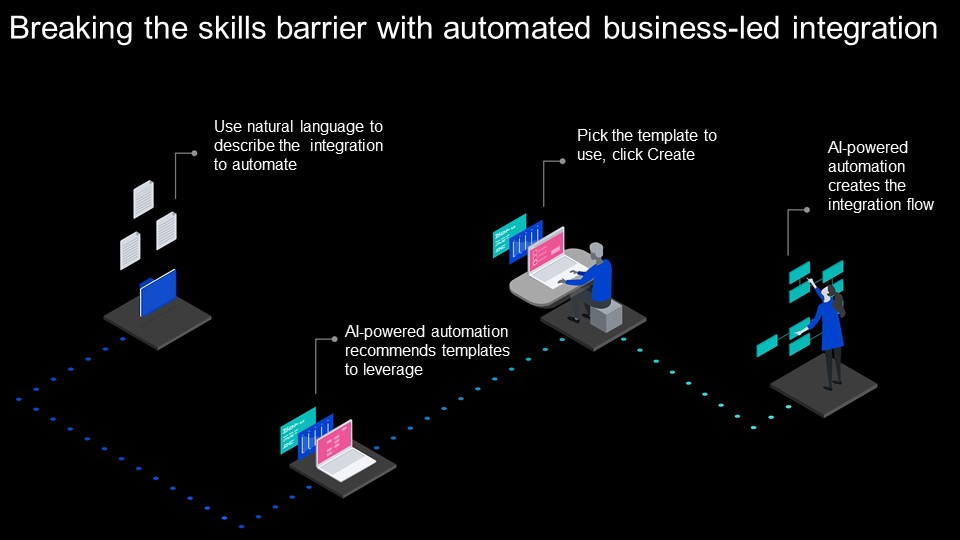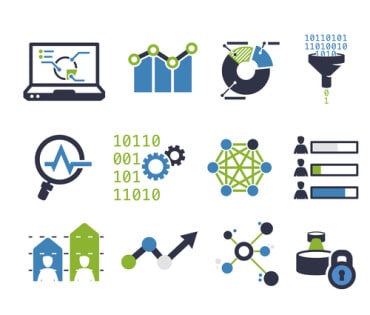
Automation can help enable a revolution in business-led integration, playing an important role in several integration steps.
The confluence of several revolutionary trends over the last year has focused attention on the need for rapid enterprise change and innovation.
First, digital transformation, which had been underway in many businesses for years, became essential due to the disruptions of the pandemic. Six months into the pandemic, CIOs cited the need to react more quickly as the top reason for making changes to their organizations.
![Featured Resource: A modern approach to hybrid cloud integration helps CVS turn vision into action [Watch Now]](https://no-cache.hubspot.com/cta/default/8019034/a5929c68-13e6-42ec-8ad3-a34cd7838f3e.png)
A second pervasive theme across industries is that every company is a tech or software company. The common example many cite is how Domino Pizza is a tech company that happens to deliver pizza. The point being is that every company today interacts with its clients and delivers products and services via applications.
The common thread needed to be successful in these areas is integration. Specifically, businesses must be able to easily integrate applications, data, and systems when digitally transforming and developing modern applications to run their operations and provide exceptional customer experiences.
Shortcomings of traditional integration approaches
Why such a great focus on integration? Seventy percent of digital transformation projects fail due to a lack of integration quality.
Traditional approaches to integration are failing to meet business needs with the changes and dynamic usage growth happening much faster than before. The manual steps and reliance on individually skilled users working sequentially on unique integrations for each requirement means the process is rigid and resistant to improvement. All integrations, whether small or large, end up requiring similar efforts that could be weeks or months per integration.
The stakeholders in the lines of business end up frustrated because of the long timeframes involved. And in many cases, they may miss a business opportunity because the integrations could not be provided quickly enough. The business side of the house might be willing to accept a delay if it were a one-time thing and the integration could be reused going forward. But that is not the case. Traditionally, every integration is built from scratch. The problem gets worse over time because each new integration needs to go through all the same friction points and creates a growing maintenance burden.
This approach also brings with it a level of risk. Specialty skills are required to design, build, deploy and maintain the integration since each project is so customized. Today, businesses find it is much harder to find and maintain the required specialty skills that built the integrations in the first place. The skills problem is becoming more acute. Many people with the knowledge and skills needed to work on legacy systems are retiring. Others are opting to leave their jobs or enter new fields leading to what many call the great resignation. And younger tech staff is harder to retain due to the great demand for their talents.
Challenges to overcome
Traditional approaches to integration end up creating three main challenges.
First, there are many manual tasks throughout the integration lifecycle, from creation and deployment to operation and maintenance. For example, mapping fields in integration flows, creating the integration flows themselves, writing API tests, and more. These manual tasks have always required expert integration skills. This slows down the speed of any digital transformation projects due to a limited number of integration experts. And this, in turn, leads to frustration in that the integration teams cannot keep up with the line of business application teams.
Second, there is not enough insight, or action on the insight, of what is happening in the business as different parts are integrated together. When problems occur in these integrations, time is wasted on problem determination. Even if a problem in a specific integration is fixed, the lessons learned are not applied to other deployed integrations doing similar tasks. And problems in operation, if found, are fixed individually rather than fed back into the integration lifecycle where they could be used to improve the process. These inefficiencies remain hidden because companies lack operational visibility to continuously improve integrations, learning from their own data collected from current and past integration experiences.
And third, integration teams are siloed. All of them have different approaches, skills, and deployment behaviors. Each team performs its own integration tasks based on these preferences rather than best practices. They all feel their integration approach is the way to solve the wider set of business integration problems.
A break with the past
Given these challenges, what’s the solution? Automation is the answer. Automation can help enable a revolution in business-led integration, playing an important role in several integration steps, either removing the need for skilled manual work, or making it easier for virtually anyone to do.
Going hand-in-hand with automation is the need for other technologies like artificial intelligence (AI) and no-code development techniques that make integration processes easier to perform by the lines of business.

In just one example of how this works, AI in the form of natural language processing (NLP) might be used at the start of a project that requires integration. The business team could then simply describe the integration it needs. An AI-powered automation solution could then use those words to recommend various reusable integration templates the team might use in its project. And finally, an AI-powered automation solution would help to customize the steps in the integration workflows once the business team selects a template.
These are all areas where IBM Cloud Pak for Integration can help. With Cloud Pak for Integration’s capabilities, such as natural language processing (delivered through IBM Watson), businesses can employ a powerful no-code experience as they define the integration they want to build (and automate). Watson provides a list of pre-built templates that fit the need and gives a percentage estimate of how relevant the template is to the input. After picking the right template, a user simply clicks create, and the flow is defined.
With these capabilities, users can simply start typing what they want in their integration. For example, if they want to take data from a specific application or service and move it into another application or service. The input, in plain text, will be understood and matched with a selection of pre-built integration templates even as the user is still typing. These templates could be further enhanced with custom-built templates giving the widest possible coverage to allow more and more integrations to be quickly, simply, and automatically created by any user. This feature is called code-assist, which brings immediate productivity improvement to developers.
The end result of using IBM Cloud Pak for Integration is the ability to speed the creation and use of integrations and reduce the requirement for highly skilled integration specialists to do many of the tasks needed.
Ready to speed the creation and use of your integrations? Start your free trial.







